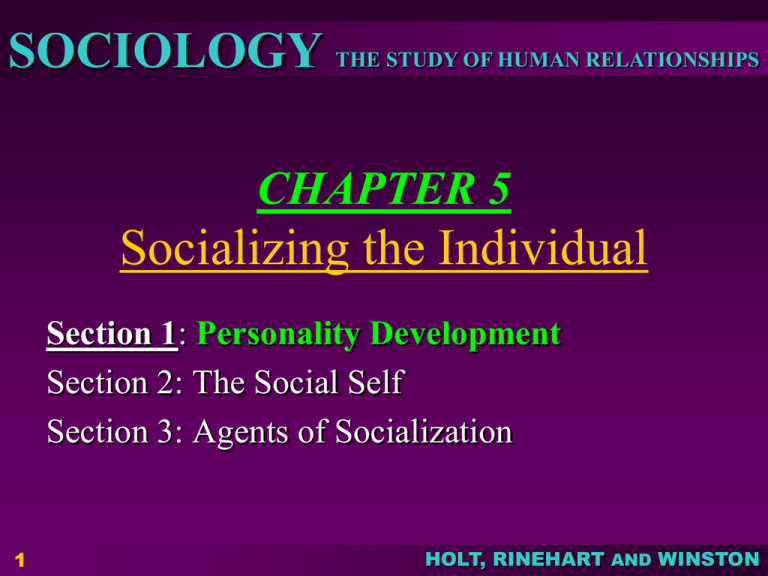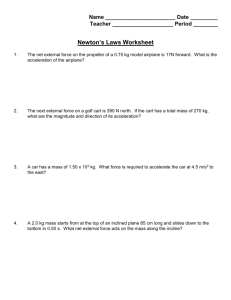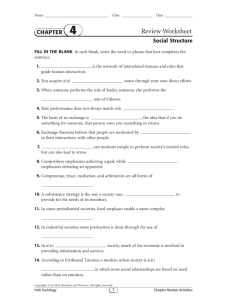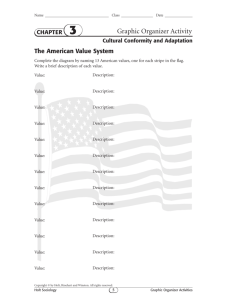CHAPTER-51
advertisement

SOCIOLOGY THE STUDY OF HUMAN RELATIONSHIPS CHAPTER 5 Socializing the Individual Section 1: Personality Development Section 2: The Social Self Section 3: Agents of Socialization 1 HOLT, RINEHART AND WINSTON SOCIOLOGY THE STUDY OF HUMAN RELATIONSHIPS Section 1: Personality Development Objectives: Identify the four main factors that affect the development of personality. Explain how isolation in childhood affects development. 2 HOLT, RINEHART AND WINSTON SOCIOLOGY THE STUDY OF HUMAN RELATIONSHIPS What is Personality?? Personality: The sum total of behaviors, attitudes, beliefs, and values that are characteristic of an individual. At an older age, personality traits change at a slower rate. However, development varies from individual to individual. 3 HOLT, RINEHART AND WINSTON SOCIOLOGY THE STUDY OF HUMAN RELATIONSHIPS Can a person’s personality contribute to eating disorders????? 4 HOLT, RINEHART AND WINSTON SOCIOLOGY THE STUDY OF HUMAN RELATIONSHIPS Can a person’s personality contribute to eating disorders????? "Patients with personality disorders exhibit feelings of ineffectiveness, a strong need to control one's environment, inflexible thinking, perfectionism, and overly restrained initiative and emotional expression ... Bulimics show a greater tendency to have impulsecontrol problems, abuse alcohol or other drugs, and have a greater frequency of suicide attempts.“ (Sam Vankin) 5 HOLT, RINEHART AND WINSTON SOCIOLOGY THE STUDY OF HUMAN RELATIONSHIPS The current view of orthodoxy is that the eating disordered patient is attempting to reassert control over her life by ritually regulating her food intake and her body weight. In this respect, eating disorders resemble obsessive-compulsive disorders. 6 HOLT, RINEHART AND WINSTON SOCIOLOGY THE STUDY OF HUMAN RELATIONSHIPS Nature vs. Nurture: Nature: Heredity: the transmission of genetic characteristics from parents to children. Instinct: unchanging, biologically inherited behavior pattern. EX: birds migrating 7 HOLT, RINEHART AND WINSTON SOCIOLOGY THE STUDY OF HUMAN RELATIONSHIPS Nurture: Behavior is result of social environment. EX: Your friends can shape your personality. 8 HOLT, RINEHART AND WINSTON SOCIOLOGY THE STUDY OF HUMAN RELATIONSHIPS Sociobiology: The systematic study of the biological basis of all social behavior. They believe that most of behavior is determined by biological factors. 9 HOLT, RINEHART AND WINSTON SOCIOLOGY THE STUDY OF HUMAN RELATIONSHIPS What do most sociologists believe???? Assume that personality and social behavior result from a blending of hereditary and social environmental influences. 10 HOLT, RINEHART AND WINSTON SOCIOLOGY THE STUDY OF HUMAN RELATIONSHIPS Section 1: Personality Development Factors That Shape Personality Development Heredity – physical traits, aptitudes (capacity to learn a particular skill), inherited characteristics, biological drives. Parents – parental characteristics, such as age, education, religion, and economic status. Birth order – personalities are shaped by whether one has siblings. (1st born: goal-oriented/last-born: more social oriented; risk-takers). Cultural environment – determines the basic HOLT, RINEHART AND WINSTON 11 personality types found in a society. (EX: male vs. female) SOCIOLOGY THE STUDY OF HUMAN RELATIONSHIPS Are you a product of your cultural environment?? 1. 2. 3. 4. 5. 12 Does the term Dalai Lama best describe a spiritual leader or an Eastern religion? If someone gave you some Lapsang souchong, would you spread it on bread or drink it? Is Lhasa a type of dog or a capital city? In which country do you think yak butter is an important part of the people’s diet- India, Russia, or Tibet? The English translation for the word Chomolungma is “Goddess Mother of the World.” What do you think Chomolungma is? HOLT, RINEHART AND WINSTON SOCIOLOGY THE STUDY OF HUMAN RELATIONSHIPS Are you a product of your cultural environment?? Turn to page 104 in textbook!! Tibet: A historical region of central Asia between the Himalaya and Kunlun mountains. A center of Lamaist Buddhism, Tibet first flourished as an independent kingdom in the seventh century. It fell under Mongol influence from the 13th to the 18th century and later came under Chinese control (1720). 13 HOLT, RINEHART AND WINSTON SOCIOLOGY THE STUDY OF HUMAN RELATIONSHIPS Isolation in Childhood: Feral children: Wild or untamed children. Children isolated in their homes by parents/family members Children had not reasoning ability or no manners, and no ability to control their bodily functions. 14 HOLT, RINEHART AND WINSTON SOCIOLOGY THE STUDY OF HUMAN RELATIONSHIPS Anna and Isabelle Anna: Confined to an attic at 6 months old. Result: (age 6) Could not walk, talk, feed herself, expressionless face. Later on: could eventually talk, feed herself, could talk in phrases…died at 10 years old. 15 HOLT, RINEHART AND WINSTON SOCIOLOGY THE STUDY OF HUMAN RELATIONSHIPS Isabelle: She and her deaf mother confined to a dark closet. Result: Used gestures to communicate Did not learn to speak Crawled on her hands and knees Made grunting, animal-like sounds Ate with hands Later On…: Able to overcome her early social deprivation due to the constant contact with her mother. 16 HOLT, RINEHART AND WINSTON SOCIOLOGY THE STUDY OF HUMAN RELATIONSHIPS Genie: Confined at age of 20 months to a small bedroom. Tied to an infant's potty-chair and nights wrapped in a sleeping bag. Totally silent world!! Toys: 2 plastic raincoats; empty cottage cheese container! 17 HOLT, RINEHART AND WINSTON SOCIOLOGY THE STUDY OF HUMAN RELATIONSHIPS Result of Genie: Discovered at 13 years old. Could not stand straight!! Social/Psychological skills of one-year-old. At 21 years of age, still could not function as a social being. 18 HOLT, RINEHART AND WINSTON SOCIOLOGY THE STUDY OF HUMAN RELATIONSHIPS Institutionalization: Children in orphanages and hospitals: Children wasted away from lack of love and attention. After Psychologist Rene Spitz studied an orphanage in 1945… Fewer than 25% could walk by themselves, dress themselves, or use a spoon. 19 HOLT, RINEHART AND WINSTON SOCIOLOGY THE STUDY OF HUMAN RELATIONSHIPS Section 1: Personality Development Isolation in Childhood and Development Research shows that a healthy cultural environment is essential for a child’s full development. Isolation can lead to severe effects such as causing children to waste away and die or to have stunted development. 20 HOLT, RINEHART AND WINSTON SOCIOLOGY THE STUDY OF HUMAN RELATIONSHIPS End of Chapter 5: Section1 21 HOLT, RINEHART AND WINSTON SOCIOLOGY THE STUDY OF HUMAN RELATIONSHIPS Chapter 5:2 The Social Self 22 HOLT, RINEHART AND WINSTON SOCIOLOGY THE STUDY OF HUMAN RELATIONSHIPS Section 2: The Social Self Objectives: Explain how a person’s sense of self emerges. Identify and describe the theories that have been put forth to explain the process of socialization. 23 HOLT, RINEHART AND WINSTON SOCIOLOGY THE STUDY OF HUMAN RELATIONSHIPS Section 2: The Social Self How Sense of Self Emerges Through interaction with social and cultural environments people are transformed into members of society The interactive process through which people learn the basic skills, values, beliefs, and behavior patterns of a society is called socialization Self: Your conscious awareness of possessing a distinct identity that separates you and your environment from other members of society. 24 HOLT, RINEHART AND WINSTON SOCIOLOGY THE STUDY OF HUMAN RELATIONSHIPS Section 2: The Social Self Three Theories of Socialization 1. John Locke – The Tabula Rosa 2. Charles Horton Cooley – The Looking Glass Self 3. George Herbert Mead – Role-Taking 25 HOLT, RINEHART AND WINSTON SOCIOLOGY THE STUDY OF HUMAN RELATIONSHIPS Section 2: The Social Self John Locke – The Tabula Rosa Each person is a blank slate at birth (tabula rosa), with no personality. People develop personality as a result of their social experiences. Moreover, infants can be molded into any type of person. 26 HOLT, RINEHART AND WINSTON SOCIOLOGY THE STUDY OF HUMAN RELATIONSHIPS Do you agree with Locke?????? Do you believe that socialization is a process by which individuals absorb the aspect of their culture with which they come into contact???? 27 HOLT, RINEHART AND WINSTON SOCIOLOGY THE STUDY OF HUMAN RELATIONSHIPS Section 2: The Social Self Charles Horton Cooley – The Looking Glass Self Infants have no sense of person or place. Children develop an image of themselves based on how others see them. Looking-glass self Other people act as a mirror, reflecting back the image a child projects through their reactions to the child’s behavior. 28 HOLT, RINEHART AND WINSTON SOCIOLOGY THE STUDY OF HUMAN RELATIONSHIPS Need an Example???? A child will develop a sense of self by the way his/her primary group members act around them (EX: parents, brothers, sisters, aunts, uncles, etc….) If parents treat a child as capable and competent ….then will produce a capable and competent child. HOLT, RINEHART AND WINSTON 29 SOCIOLOGY THE STUDY OF HUMAN RELATIONSHIPS Section 2: The Social Self George Herbert Mead – Role-Taking People not only come to see themselves as others see them but also take on or pretend to take on the roles of others through imitation, play, and games. Role-taking: taking or pretending to take the role of others. This process enables people to anticipate what others expect of them. 30 HOLT, RINEHART AND WINSTON SOCIOLOGY THE STUDY OF HUMAN RELATIONSHIPS George Mead (Cont’d) Significant others: Specific people, such as parents, brothers, sisters, other relatives, and friends, who have a direct influence on our socialization. Generalized other: Internalized attitudes, expectations, and viewpoints of society that we use to guide our behavior and reinforce our sense of self. 31 HOLT, RINEHART AND WINSTON SOCIOLOGY THE STUDY OF HUMAN RELATIONSHIPS George Mead (Cont’d) He believes the self consists of 2 related parts: 1. I: the unsocialized, spontaneous, self-interested component of personality and self-identity. 2. Me: the part of yourself that is aware of the expectations and attitudes of society – the socialized self. ** To be a well-rounded member of society, a person needs BOTH aspects of the self! 32 HOLT, RINEHART AND WINSTON SOCIOLOGY THE STUDY OF HUMAN RELATIONSHIPS Chapter 5: Section 3 Agents of Socialization 33 HOLT, RINEHART AND WINSTON SOCIOLOGY THE STUDY OF HUMAN RELATIONSHIPS Section 3: Agents of Socialization Objectives: Identify the most important agents of socialization in the United States. Explain why family and education are important social institutions. 34 HOLT, RINEHART AND WINSTON SOCIOLOGY THE STUDY OF HUMAN RELATIONSHIPS Agents of Socialization: The specific individuals, groups, and institutions that enable socialization to take place. 35 HOLT, RINEHART AND WINSTON SOCIOLOGY THE STUDY OF HUMAN RELATIONSHIPS Section 3: Agents of Socialization Agents of Socialization 1. Family: – most important agent Principal socializer of young children. Intended vs. unintended socialization. “Do as I say, not as I do.” 36 HOLT, RINEHART AND WINSTON SOCIOLOGY THE STUDY OF HUMAN RELATIONSHIPS Agents of Socialization: 2. Peer group: – primary group composed of individuals of roughly equal age and social characteristics, particularly influential during preteenage and early teenage years. Peer-group goals are sometimes at odds with the goals of the larger society…can be alarming to family. 37 HOLT, RINEHART AND WINSTON SOCIOLOGY THE STUDY OF HUMAN RELATIONSHIPS Agents of Socialization: 3. School: – plays a major role! Much of socialization is deliberate. Also, unintentional socialization EX: Teachers become models, such as manners of speech, styles of dress, etc…. 38 HOLT, RINEHART AND WINSTON SOCIOLOGY THE STUDY OF HUMAN RELATIONSHIPS Agents of Socialization: 4. Mass media: – books, films, the Internet, magazines and television, not face-to-face. 39 HOLT, RINEHART AND WINSTON SOCIOLOGY THE STUDY OF HUMAN RELATIONSHIPS The Mass Media (Cont’d) 98% of homes in U.S. have TVs. (Average: More than 2 per home) 6-17 years old: TV is the primary after-school activity! Spend twice as much time watching TV than in school! 40 HOLT, RINEHART AND WINSTON SOCIOLOGY THE STUDY OF HUMAN RELATIONSHIPS The Mass Media (Cont’d) Violence in the Media: By age 18… Witnessed 200,000 fictional acts of violence 16,000 murders Studies suggest that violence encourages viewers to act in aggressive ways and to see aggression as a valid way to solve problems. 41 HOLT, RINEHART AND WINSTON SOCIOLOGY THE STUDY OF HUMAN RELATIONSHIPS The Mass Media (Cont’d) Positive Side: Television expands the viewers’ world. Educational tool. 42 HOLT, RINEHART AND WINSTON SOCIOLOGY THE STUDY OF HUMAN RELATIONSHIPS Section 3: Agents of Socialization Overall Importance of Family and Education Teach children important life skills. Teach values, norms, and beliefs. 43 HOLT, RINEHART AND WINSTON SOCIOLOGY THE STUDY OF HUMAN RELATIONSHIPS Resocialization: Total institution: A setting in which people are isolated from the rest of society for a set period of time and are subject to tight control. EX: Prisons, military boot camp, and psychiatric hospitals. 44 HOLT, RINEHART AND WINSTON SOCIOLOGY THE STUDY OF HUMAN RELATIONSHIPS Resocialization: Involves a break with past experiences and the learning of new values and norms. Goal: To change an individuals personality and social behavior. Individual identity taken away! (EX: hair cut; uniforms; etc….) Once self is weakened, then easier to convince others to conform to new patterns of behavior. 45 HOLT, RINEHART AND WINSTON








